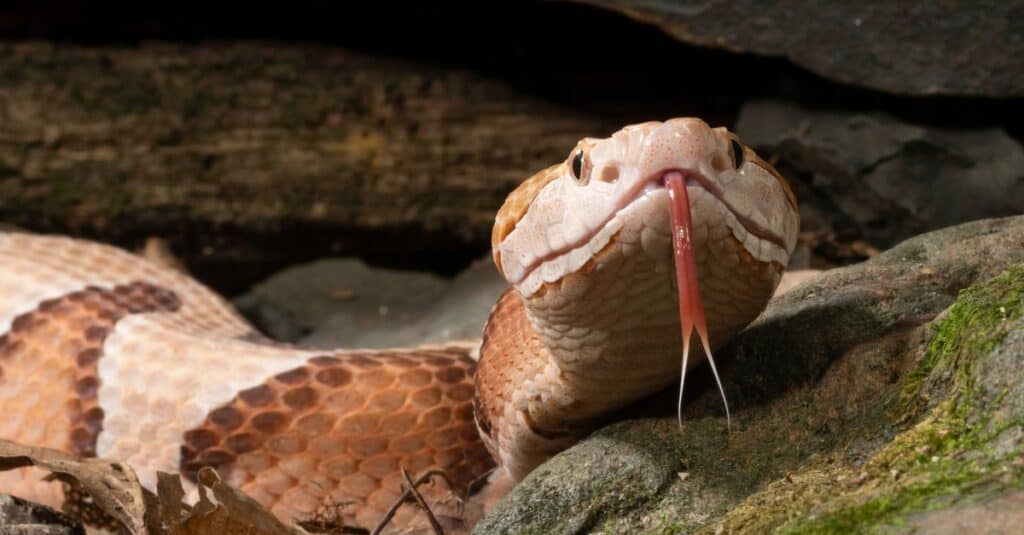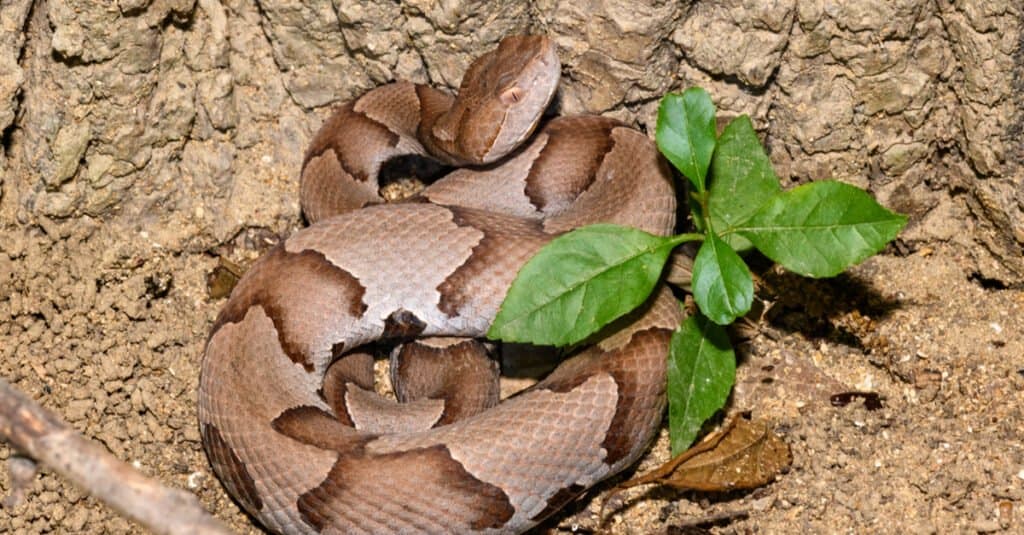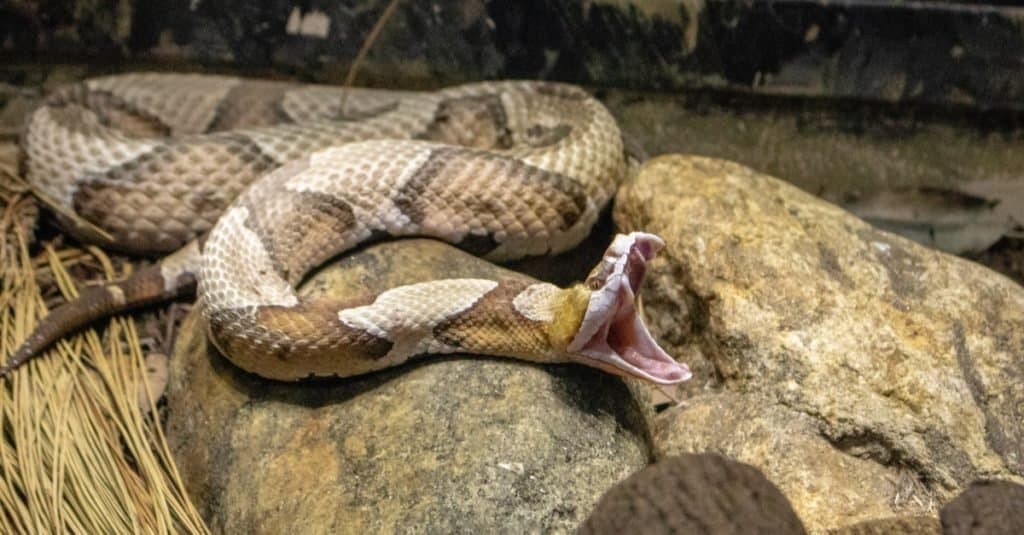There are copperheads living across much of the eastern half of North America. Copperheads in Maryland aren’t the only venomous snake you have to worry about, there’s also the infamous timber rattlesnake. In addition to these dangerous snakes, Maryland is also home to over 20 non–venomous species of snakes. Both the timber rattlesnake and the copperhead are members of the pit viper family, along with adders and other types of rattlesnake. Copperheads have the dubious distinction of biting more people in the United States than any other snake. Fortunately, their venom is rarely life-threatening.
Here, we’ll learn more about copperheads in Maryland, starting with where you might find them. We’ll explore their size, appearance, behavior and how to differentiate them from other snakes. Then, we’ll discover exactly the precise parts of Maryland this snake calls home and whether or not there are copperheads in Baltimore.
Read on to learn more about copperheads in Maryland!
Copperhead: The Facts
Copperheads are relatively small venomous snakes. Their range extends from southern Texas in the west to Maine in the north. They have distinct copper-colored heads and medium-weight bodies. Copperheads in Maryland are dangerous snakes that should be treated with respect and caution. They are opportunistic feeders, eating whatever they can swallow. For juveniles, this often means insects, lizards, and small frogs or toads; as they grow, copperheads shift to bigger prey and add mice and rats to their diet.
Appearance and Size

Copperheads in Maryland look superficially similar to timber rattlesnakes, though they lack rattles.
©Joe McDonald/Shutterstock.com
Copperheads are small, especially when compared to giants like the Burmese python and green anaconda. They grow to about three feet long, with medium-heavy bodies. The most striking aspect of their appearance is the intricate, hourglass-shaped markings across their backs and sides. These snakes also have triangular-shaped heads, with vertically elliptical pupils, like a cat’s eyes.
Juvenile copperheads have bright green or yellow tails, which scientists think they use to attract prey. As they age, they lose their bright tails. Adult copperheads have striking copper-colored heads and tan bodies with darker markings. The largest copperheads grow to over 50 inches long, though copperheads of this size are rare.
Location and Habitat
Copperheads in Maryland are widespread. They occur in all but a few of the state’s easternmost counties. These snakes are native to North America, where they inhabit almost every state in the eastern half of the country. There are no copperheads the Great Lakes region, or the northern and westernmost parts of the country.
Behavior
Copperheads spend their summers hunting at night, and the rest of the year hunting during the day. They’re active ambush predators and prefer cicadas, mice, birds, lizards, voles, caterpillars, and other small creatures. As a means of self-defense, copperheads often ‘rattle’ their tails in mimicry of rattlesnakes. If they happen to be in dry leaves, they can actually make a sound very similar to the warning rattle of a rattlesnake. They’re not very large snakes and often fall prey to hawks, eagles, and larger snakes.
Where are Copperheads Found in Maryland?

Copperheads in Maryland live in almost all of the state’s counties, with the exception of a few eastern counties.
©Jeff W. Jarrett/Shutterstock.com
There are copperheads throughout most of Maryland. Their preferred habitats include lightly wooded areas, sandy ridges near swamps, agricultural fields, and unused fields. Copperheads are habitat generalists, and will basically go wherever they can find food and shelter. Because they like to stay hidden, you’re more likely to encounter them in places with plenty of plants or debris to hide under.
What do Copperheads Look Like in Maryland?
The most distinguishing feature of copperheads in Maryland is their wide, copper-colored head and distinct markings. Copperheads have a base tan or light brown color with evenly spaced, hourglass-shaped markings across their sides and back. Because they’re pit vipers, they have venom glands, large fangs at the front of their mouth, and heat-sensing pits behind their nostrils. But, if you see a snake, and think it might be a copperhead, don’t lean in for a closer look. Copperheads are hesitant to bite, but should not be approached, as this increases your chances of sustaining a bite.
What Months are Copperheads in Maryland Most Active?

Copperheads are active in the summer.
©Suzanna Ruby/Shutterstock.com
Copperheads are most active in the summer and early fall months. Females give birth to snakelings in the late summer, so you’re more likely to see baby copperheads in the fall. Like most snakes, they slow in the winter, and go into brumation (similar to hibernation) when the temperatures dip below about 60ºF. However, on warm winter days they may come out to sun themselves and get a drink of water. Copperheads become active again in the spring and remain active through the warm parts of the year.
Are there Copperheads in Baltimore?
Copperheads in Maryland aren’t generally known as suburban or urban snakes, but it’s not unheard of for them to wander into Baltimore. Generally, they follow the food, like mice and cicadas. Copperheads in Baltimore are rare, but, if they do make their way into the city, they’re likely to be found hiding among debris or tall grass.
Do Copperheads in Maryland Bite?
Unfortunately, copperheads in Maryland do bite. But, they only do so in self-defense. Copperheads like to hide under things, especially during the day, so most bites happen when humans reach into unknown places. Copperhead snakes are cryptic creatures, which means they would rather hide or flee than bite. They’re known as shy, docile snakes.
With prompt medical attention, copperhead bites are not life-threatening, though they can be extremely painful. If you’ve been bitten by a copperhead, seek immediate medical attention.
The photo featured at the top of this post is © iStock.com/David Kenny
Discover the "Monster" Snake 5X Bigger than an Anaconda
Every day A-Z Animals sends out some of the most incredible facts in the world from our free newsletter. Want to discover the 10 most beautiful snakes in the world, a "snake island" where you're never more than 3 feet from danger, or a "monster" snake 5X larger than an anaconda? Then sign up right now and you'll start receiving our daily newsletter absolutely free.
Thank you for reading! Have some feedback for us? Contact the AZ Animals editorial team.






